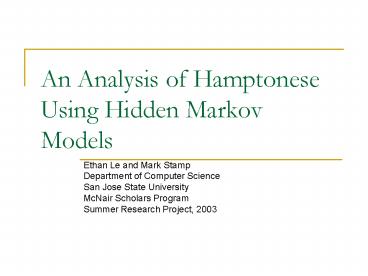An Analysis of Hamptonese Using Hidden Markov Models PowerPoint PPT Presentation
Title: An Analysis of Hamptonese Using Hidden Markov Models
1
An Analysis of Hamptonese Using Hidden Markov
Models
- Ethan Le and Mark Stamp
- Department of Computer Science
- San Jose State University
- McNair Scholars Program
- Summer Research Project, 2003
2
(No Transcript)
3
(No Transcript)
4
(No Transcript)
5
Agenda
- James Hampton
- Purpose
- What is Hamptonese?
- Hidden Markov Models (HMMs)
- HMMs and Hamptonese
- Other approach
- Results
- Questions
6
James Hampton
- WWII veteran
- Janitor in Washington D.C.
- Life of solitude
- Died in 1964
- Hamptonese discovered after his death
- The Throne also found
7
The Throne of the Third Heaven of the Nations
Millennium General Assembly
James Hampton alongside his Throne
Pieces of The Throne
8
Purpose
- Analyzed Hamptonese using Hidden Markov Model to
determine whether Hamptonese was created using
simple substitution of English letters (or other
languages). - Consider alternative interpretations of Hamptonese
9
What is Hamptonese?
10
What is Hamptonese? (Contd)
- Unknown origin and content
- Spans 167 pages
- Could it be
- A cipher system?
- Gibberish?
- Example of human randomness?
- Other?
11
Hidden Markov Models (HMMs)
- Markov process with hidden states
- HMMs provide probabilistic information about the
underlying state of a model, given a set of
observations of the system.
12
HMMs (Contd)
- Three solvable problems
- Find probability of observed sequence
- Find optimal state sequence
- Train the model to fit observations
13
HMMs examples
- Example 1 Music Information Retrieval System
(MIR) - Example 2 Deciphering English text (Cave and
Neuwirth) - 27 symbols (alphabet letters plus space)
- Assume 2 hidden states
- Train HMM to best fit input data
- Results separation of consonants and vowels
14
HMM Example (Contd) English Text
Character Initial Final
A 0.03685 0.03793 0.0044447 0.1306242
B 0.04007 0.03978 0.0241154 0.0000000
C 0.03362 0.03423 0.0522168 0.0000000
D 0.03777 0.03654 0.0714247 0.0003260
E 0.03409 0.03608 0.0000000 0.2105809
F 0.03685 0.03932 0.0374685 0.0000000
G 0.03593 0.03839 0.0296958 0.0000000
H 0.03961 0.03932 0.0670510 0.0085455
I 0.04007 0.03377 0.0000000 0.1216511
J 0.03501 0.03515 0.0065769 0.0000000
K 0.03685 0.03700 0.0067762 0.0000000
15
HMMs and Hamptonese
- Transcribed 103 pages
- About 30,000 observations
- More than 40 distinct symbols
- Assume 2 hidden states
- 3 different reading techniques
16
Other Approach
- Hamptonese vs. 246 different languages
- HMM for other languages
- Religious references organizational patterns
- Analysis of first 40 pages
- Pattern recognition
17
Results
- Hamptonese is not a simple substitution for
English letters - Hamptonese is probably not a simple substitution
for any other language - First comprehensive study of Hamptonese
- Transcription of entire text
- Future research suggestions
18
Acknowledgments
- Dr. Mark Stamp
- SJSU McNair Scholars Program
- SCCUR
- UC Irvine
19
Questions???
20
References
- Chai, Wei and Vercoe, Barry. (n.d.). Folk Music
Classification Using Hidden Markov Models. MIT
Media Lab. - M. Stamp, A revealing introduction to Hidden
Markov Modelshttp//www.cs.sjsu.edu/faculty/stamp
/Hampton/HMM.pdf - M. Stamp and E. Le, Hamptonese website.http//www
.cs.sjsu.edu/faculty/stamp/Hampton/hampton.html - R.L. Cave and L.P. Neuwirth, Hidden Markov Models
for English, in Hidden Markov Models for Speech,
IDA-CRD, Princeton, NJ, 1980

